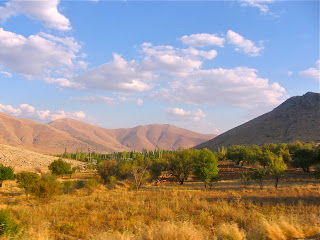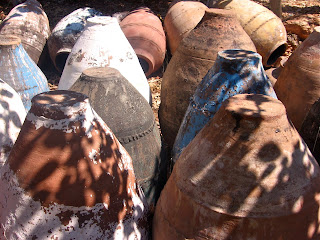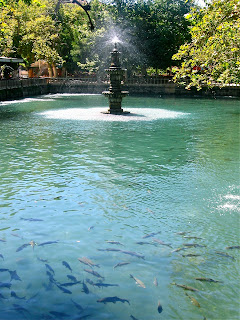 |
| The outskirts of Vakifli, the last remaning ethnic Armenian village in Turkey. |
Yesterday we made a quiet but meaningful trip to Musa Dagh, the site of the village of some of my ancestors (it would be disingenuous not to note that I could surely make similar trips to Poland, Switzerland and the UK, but I wouldn't know quite where to go). We have been staying in Antakya (also known as Hatay and best known as the great city of Antioch), which is the closest small city with good accommodation options, amenities and points of interest.
It also happens to be the "town" that my ancestors would go to just as my folks might drive to Poughkeepsie for the day or Brendan's might drive over to Bangor. My great great grandfather was involved in the silk business there. I'll probably post more about Hatay later.
From Hatay, public transportation to Musa Dagh is a bit dodgy, although it does exist. You have to take a dolmus - a small van-like minibus - to the town of Samandag near the Mediterranean coast and then transfer to a rickety bus, van or dolmus (or back of a truck or whatever you can finagle) up the mountain. There is an official dolmus service but it is so infrequent that most people grab rides informally. The view on the way up grows more stunning as you climb, past farms and orange orchards with rocky bluffs and cultivated fields in the difference, all under a crystal blue sky.
This was the first time that I've felt comfortable in Turkey openly stating my reasons for being here, and for being candid about my origins: Vakifli is a small village but there are enough Armenians around that I felt I could openly, well, be who I am.
 |
| Bitias (my home village) is long gone, the residents having relocated to Anjar in Lebanon when Hatay returned to Turkey. The land out beyond that golden lump and farmed rows is where one resident of Vakifli told me Bitias was once located. |
I didn't really know what I expected to find - I went up more for personal reasons than to see anything in particular or make any specific discoveries. I've wanted to make this trip for years and, being the big traveler in the family (although I have other relatives who have traveled extensively I'm the one who seems to have turned it into a lifestyle) it seemed inevitable that it would eventually happen. As we climbed Musa Dagh, I can say that a calming feeling did come over me - although I think this is less an ancient attachment to the land than a feeling of peace at having finally made the trip to be there (as in, it came from my ego, not my id).
It is a difficult thing to think, but it's true: that side of my family was quite prosperous in Bitias. If the genocide had never occurred, if there had been no Forty Days of Musa Dagh, they would not have left for America. My grandfather would have never met my grandmother while he was at RPI. My mother would have never been born, let alone met my father.
So I can say that "if things had happened differently I would have grown up around here" but it's not true: I would not exist at all.
Despite the grittiness of the photo above, Vakifli is a prosperous village - they are making a name for themselves in organic farming and earning big bucks for it, and being the last remaining Armenian village in Turkey, they have close ties to some very deep pockets in the Armenian community in Istanbul as well as the diaspora. It is a popular vacation spot for members of the diaspora coming home as well as a summer destination for Istanbul Armenians. I was surprised by how neat, tidy and prosperous it was: new stone buildings, neatly paved roads (mostly), a well-tended cemetery, fecund orange orchards and farms, people dressed neatly and driving nice, new-looking cars.
The swingset was just about the only broken-down thing in the place. Not really what you expect from a mountain village in Turkey or any country that is not quite First World (although I'd argue that Turkey is not too far from Taiwan in terms of development, mostly), but hey. That's Armenians for you.
 |
| The church in Vakifli |
For those who don't know - you should. When the mass murders and deportations were occurring across Turkey around 1915, the residents of the eight Armenian villages of Musa Dagh managed to resist and hold off the Turkish forces for forty days, hiding in the mountains and fighting back. My great grandfather was among them along with other distant relatives. They held out and were nearly out of supplies when they were rescued by French ships (note the Mediterranean below, it's not that far away and quite visible from Musa Dagh) and taken to Port Said, Egypt. The episode is known as the Forty Days of Musa Dagh, which is also a novel based on true events. It's the reason why the residents of those villages were not deported or massacred (although many died), and why they were all still there until the 1930s, when Hatay united with Turkey: that's why they were there at all and decided to leave, not wanting to return to the rule of a country whose government had tried to murder them.
My family ended up in the USA, of course, as did other distant relatives.
Plaques in the church wall commemorate this. According to my mother there is also a monument up there to memorialize the resistance - we hiked the roads above Vakifli for awhile and down a few side roads but did not find it.
 |
| Musa Dagh with a view of the Mediterranean |
I am extremely proud of the courage and tough survivalism of my ancestors, which is a part of why this visit was so meaningful for me. I grew up with this story - I heard it many times and from many lips, sometimes from people who had lived through it (such as my Nana, although I couldn't understand her entirely - she did learn English but was never fully fluent in it and forgot much of it in her old age). It's not just the food, not just the kilims, not just the other assorted memories of my childhood and cultural upbringing that make me who I am and make my family who they are: this story is also there, hanging behind it all like a dark cloud, a story that is purposely told so as not to be forgotten even as generation upon generation becomes more American in both culture and looks (most of my cousins would never be guessed for Armenians. Very few of them were born with the features one normally associates with people from the Caucasus. I personally look more Polish than anything).

I also reflected on who I am today and what it meant to come here with Brendan - as much as thoughts, feelings, ideas and other bits and bobs of soul should ideally be shared with a good mate, this piece of my history is something I am ecstatic to have shared with him. I can say confidently that there is no one else I would have rather shared this journey with than my husband, and that yes, an ideal husband (or wife) is the sort of person you both can and wish to share such things with. We spent quite a bit of time sitting on a warm rock just off the road looking out at this splendid view of the mountains and sea, and though we didn't say much, just sitting there with him was more of a sharing experience than talking could have been (we also ate some Cheezy Stix).
 |
| Another mountan view out towards where Bitias once stood |
The residents of Vakifli are quite used to members of the diaspora venturing back to discover their roots - I thought I might be met with surprise but no, not at all. I'm just one in a string of foreign-born Armenians who makes the trip up here, not necessarily to see anything but just to be there and to see it with their own eyes. The town has a surprisingly hopping tea garden, and here is where you can see some cultural influence from the Turks: like others across Turkey, sitting outside, drinking tea and playing backgammon seems to be a career path in Vakifli. They may be Armenian but in this way they're just like their Turkish neighbors. A key difference - unlike most small-time tea gardens, women were welcome here and children were running around. I felt no sense of "this is the preserve of men" as I did from many tea gardens in Gaziantep and Sanliurfa, and the owner was a woman to boot. Go Armenians!

It was quite clear that we were not from around these parts, so we had the chance to chat with a few locals (although most were so used to people just like us, albeit usually older and more connected to the Armenian community, that they paid us no mind). One older man was disappointed that I don't speak Armenian but was happy to point out where Bitias once stood. At one point I got locked in the tea garden bathroom (the lock broke) and half the town came to rescue me.
All in all it was a quiet trip, a ruminative one, not one given to fresh new discoveries or heaps of things to see. Just walking on Musa Dagh, watching the Queen Anne's Lace and other dry-climate flowers shake in the Mediterranean beaches, smelling the dry earth and orange trees, waving hello to locals on tractors, visiting the church, getting horrific sunburn while peering out at sun-drenched vistas and drinking tea among fellow Armenians was what I came for, and that's what I got.
I do think that everyone with the means and interest in their origins should make a similar trip - I can't point specifically to how the visit moved me, but it did, I know it did. Wherever you are from, whatever your history, it is worthwhile to go see the place of your origin - even if it's just to lay eyes on the place.



































































